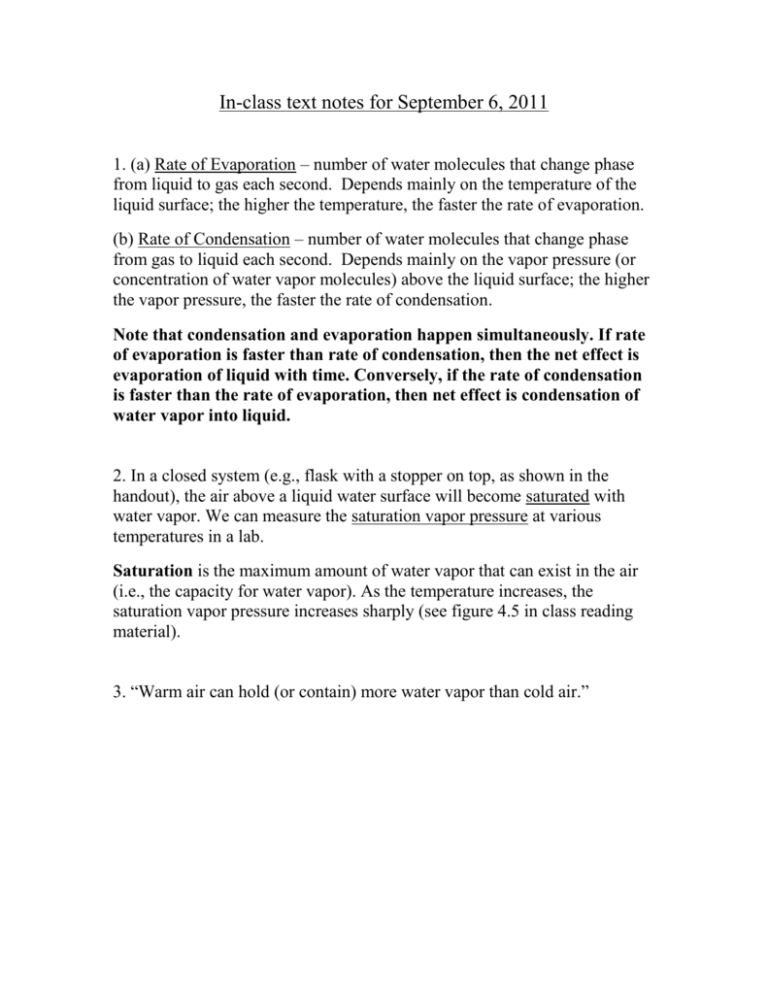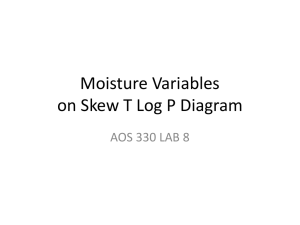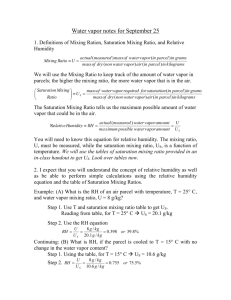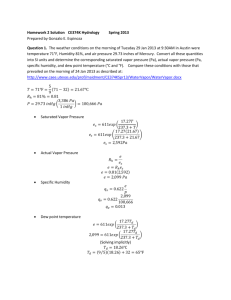WORD Document Containing text notes that will be referred to
advertisement

In-class text notes for September 6, 2011 1. (a) Rate of Evaporation – number of water molecules that change phase from liquid to gas each second. Depends mainly on the temperature of the liquid surface; the higher the temperature, the faster the rate of evaporation. (b) Rate of Condensation – number of water molecules that change phase from gas to liquid each second. Depends mainly on the vapor pressure (or concentration of water vapor molecules) above the liquid surface; the higher the vapor pressure, the faster the rate of condensation. Note that condensation and evaporation happen simultaneously. If rate of evaporation is faster than rate of condensation, then the net effect is evaporation of liquid with time. Conversely, if the rate of condensation is faster than the rate of evaporation, then net effect is condensation of water vapor into liquid. 2. In a closed system (e.g., flask with a stopper on top, as shown in the handout), the air above a liquid water surface will become saturated with water vapor. We can measure the saturation vapor pressure at various temperatures in a lab. Saturation is the maximum amount of water vapor that can exist in the air (i.e., the capacity for water vapor). As the temperature increases, the saturation vapor pressure increases sharply (see figure 4.5 in class reading material). 3. “Warm air can hold (or contain) more water vapor than cold air.” 4. Definitions of Mixing Ration, Saturation Mixing Ratio, and Relative Humidity Mixing Ratio U actual ( measured ) mass of water vapor (in parcel ) in grams mass of dry ( non water vapor) air (in parcel ) in kilograms We will use the Mixing Ratio to keep track of the amount of water vapor in parcels; the higher the mixing ratio, the more water vapor that is in the air. Saturation Mixing mass of water vapor required for saturation (in parcel ) in grams U S Ratio mass of dry (non water vapor) air (in parcel ) in kilograms The Saturation Mixing Ratio tells us the maximum possible amount of water vapor that could be in the air. Re lative Humidity RH actual ( measured ) water vapor amount U ma ximum possible water vapor amount U S You will need to know this equation for relative humidity. The mixing ratio, U, must be measured, while the saturation mixing ratio, US, is a function of temperature. We will use the tables of saturation mixing ratio provided in an in-class handout to get US. Look over tables now. 5. I expect that you will understand the concept of relative humidity as well as be able to perform simple calculations using the relative humidity equation and the table of Saturation Mixing Ratios. Example: (A) What is the RH of an air parcel with temperature, T = 25° C, and water vapor mixing ratio, U = 8 g/kg? Step 1. Use T and saturation mixing ratio table to get US. Reading from table, for T = 25° C US = 20.1 g/kg Step 2. Use the RH equation RH U 8 g / kg 0.398 or 39.8% U S 20.1 g / kg Continuing: (B) What is RH, if the parcel is cooled to T = 15° C with no change in the water vapor content? Step 1. Using the table, for T = 15° C US = 10.6 g/kg Step 2. RH U 8 g / kg 0.755 or 75.5% U S 10.6 g / kg 6. From the previous example, we can see that RH by itself does not indicate the absolute amount of water vapor in the air because it depends on temperature. In the previous example, even though the actual amount of water vapor in the parcel was the same in parts (A) and (B), the RH was different because US changed due to the temperature change. In fact there are two ways RH can change: (1) Change the water vapor content of the air (changes U) or (2) Change the temperature (changes US) 7. Dew Point Temperature ≡ Td is the temperature to which you would need to cool an air parcel for it to be saturated. It is determined by the amount of water vapor in the parcel, i.e., the mixing ratio, U … as U increases, Td increases. The dew point temperature is the answer to this question: Given the amount of water vapor that is in a parcel, what would the air temperature have to be for the parcel to be saturated with that amount of water vapor? 8. Use of Saturation Mixing Ratio Table for Td calculations. Review … given the air temperature, T, the corresponding entry in the table is the saturation mixing ratio, Us. T (corresponds with) US There is also a correspondence between the dew point temperature, Td , and the mixing ratio, U. Td (corresponds with) U 9. Example dew point calculation: If T = 10° C and RH = 50%, what is Td? Use saturation mixing ratio table, for T = 10° C US = 7.6 g/kg Use RH equation RH U U 0.5 US 7.6 g / kg Since the mixing ratio, U, is the only unknown, solve for it U = (RH) x US = (0.5) x 7.6 g/kg = 3.8 g/kg Now use the table of saturation mixing ratios to find the corresponding dew point temperature For U = 3.8 g/kg Td = 0° C








